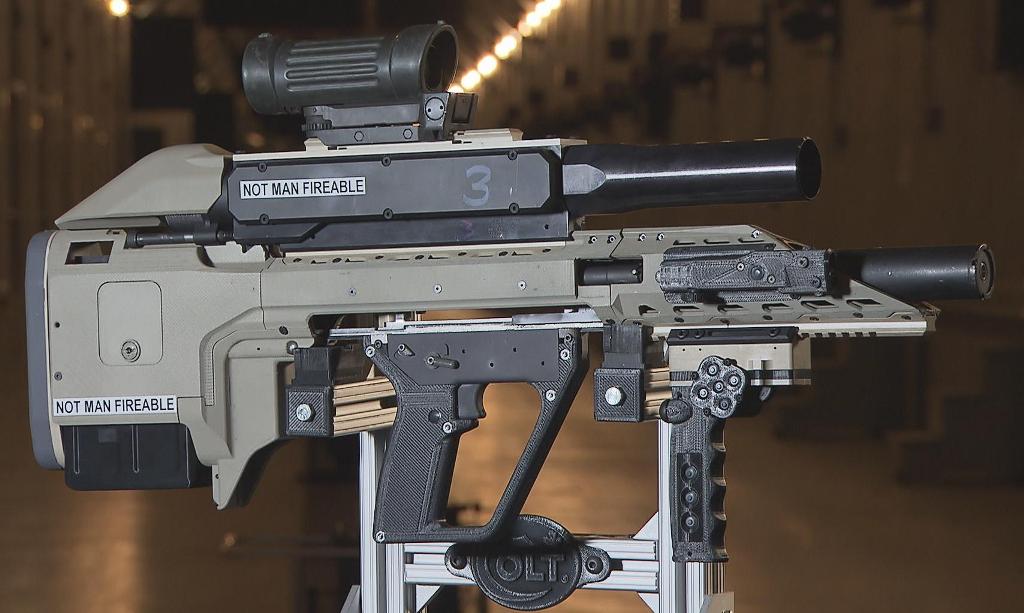When Defence Research and Development Canada released photos of a prototype for an integrated assault rifle in February, the media reaction was immediate: Canada’s defence scientists had been watching too many science fiction movies and playing too many video games. The gun, claimed the headlines, had been designed for The Fifth Element or was destined for the next version of Call of Duty.
Even DRDC-Valcartier, which is leading the project, acknowledged it looked every bit like a weapon from a sci-fi film.
To be clear, the “smart gun” is only a prototype for a program known as Future Small Arms Research (FSAR). Called the Integrated Weapon System Concept, it grew out of a 2009 project called Soldier Integrated Precision Effects Systems (SIPES) and will ultimately become integral to Soldier 2030, a long-term program intended to improve the tactical performance of the dismounted soldier.
Created by Colt Canada, the “bullpup” style rifle has provided a test bed to explore a range of integration challenges and answer a lot of questions about novel materials, processors, ammunition and sensors.
Modular in design, the weapon can fire NATO-standard 5.56 rounds or new lightweight telescoped ammunition, and can be fitted with either a three-round 40mm grenade launcher or a 12-gauge shotgun.
The prototype allowed DRDC to explore the potential of new imaging technologies on weapon sight design, and assess whether improved positioning sensors and data networking could increase the effectiveness of collective platoon operations.
 Using a NATO-standard power and data bus, the gun can accept “smart accessories” such as electro-optical sights and position sensors that connect to command and control networks. In other words, better shared situational awareness at the platoon level and more information for commanders and headquarters.
Using a NATO-standard power and data bus, the gun can accept “smart accessories” such as electro-optical sights and position sensors that connect to command and control networks. In other words, better shared situational awareness at the platoon level and more information for commanders and headquarters.
Ergonomics are central to the gun’s design. Drawing on data from operations in Afghanistan as well as a range of human factor trials performed by Human Systems, scientists were able to incorporate findings on how soldiers actually interact with their weapon. At the 2015 Army Outlook, officers with Director Land Requirements (DLR) said the FSAR was able to “validate the operational effectiveness of technology concepts through field trials based on human factors principles.”
Shedding weight through the use of new materials and case telescoped ammunition was paramount, DRDC said. “[W]hen all of the components are finally pared down to their field-ready weights, it is expected that the fully-integrated prototype should weigh in at less than a CAF standard issue Colt C7 equipped with an M203 grenade launcher.”
FSAR also sought to explore automated target detection and engagement technology, as well as sensor capability “to accurately locate targets spatially and share that target data with surrounding units and back to base.” A next step in the research, DRDC said, is to incorporate TrackingPoint-style projectile guidance technology.
Among the contract opportunities, DLR highlighted efforts around automated target detection and recognition algorithm performance using imagery taken in the visible and infrared spectrums; visual, acoustic and thermal signature reduction technologies; high performance coatings for a range of environments; and absolute or relative position location technologies for Global Navigation Satellite Systems (GNSS)-denied environments.
“In the medium term, this weapon concept represents a lethal, flexible general-purpose platform,” said Lieutenant-Colonel Serge Lapointe of the Soldier Systems group in DLR in a DRDC online article. “It will be able to operate in all theaters of operations in the most complex terrain including urban areas, mountains, jungles, deserts and the Arctic.”
So while the “smart gun” prototype might seem like a nod to a favourite science fiction movie, it is actually providing fresh data to meet modern requirements. In the end, it might evolve into a core capability for the Army’s future operating concept of Adaptive Dispersed Operations.

